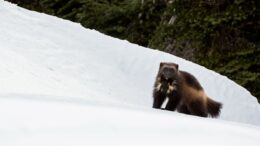Colorado Gov. Jared Polis has signed a law to allow wildlife authorities to reintroduce the North American wolverine to the state. Under the law Colorado Parks and Wildlife is expected to create new rules for a wolverine reintroduction program, as well as set guidelines for compensating ranchers and farmers for potential financial losses from any damage to livestock. (Wolverines typically prey on rabbits and other small mammals but have been known to take down animals are large as elk or moose; experts say they rarely prey on livestock.)
Colorado has been attempting to reintroduce wolverines for nearly 15 years. The state first floated a potential program in 2010, but officials opted to reintroduce lynx first. The state wildlife agency estimates Colorado is now home to as many as 250 lynx.
The Northern American wolverine’s natural habitat includes snowy, cold climates. They’ve traditionally been found in the northern Rockies and North Cascade mountain ranges and parts of Alaska and Canada. However, due to aggressive hunting, climate change, and habitat fragmentation, they have been virtually eliminated across the United States. In November 2023 the North American wolverine received federal protection as a threatened species under the Endangered Species Act. Meanwhile, the species has recently started to expand its range — one wandering wolverine was even spotted last year near Portland, Oregon, and may still be patrolling the region.
Most people will never have an opportunity to see reclusive wolverines in the wild, but they’ve appeared several times in the pages of The Revelator. Here’s some of our previous coverage of this fascinating species:
What’s Needed to Save Wolverines? A New Study Has Answers
Wolverines are notoriously elusive, which has made them hard to study. And harder to protect.
Often dwelling in high mountain reaches and denning in deep snow, wolverines (Gulo gulo) prefer to stay away from people. Although evidence has long suggested their populations have declined, some scientists and policymakers have, for years, fallen back on a common trope that not enough is known about them to warrant protective action.
But a new study published in Global Ecology and Conservation flips this narrative — and renews the call for conservation.
“It turns out we actually know a lot more than we thought we did about this creature,” says Aerin Jacob, a conservation scientist at the Yellowstone to Yukon Conservation Initiative.
Carnivore Conservation Is Tougher in the Mountains
When the Yakama Nation detected a wolverine on Washington’s Mt. Adams in 2005, outside the animal’s known distribution, Jocelyn Akins wanted to learn more. Was it part of a population that hadn’t been previously known or a lone animal seeking new territory?
To answer those questions, Akins, who had previously studied wolverines and grizzly bears in the Rocky Mountains, launched the Cascades Carnivore Project in 2008. Studying these elusive and rare mountain carnivores is no easy feat. After setting up remote camera traps with the help of friends and other volunteers, it was 15 months before they got their first photograph of a wolverine. And it wasn’t until 2018 when field researchers working with Akins documented the first female wolverine in 75 years in Washington’s South Cascade Mountains.
A Wolverine Feasts — on Fish?
Wolverine is Gulo gulo; the glutton so nice they named it twice. Across their range, they are known to eat goats, grouse, goose eggs and everything between. People have been picking apart their scat for half a century. I had never heard of anyone finding fish scales.
In the coming days, to my amazement, Nimbus marched back to the channel and sat at its center for hours, accumulating GPS locations at a baffling rate. From camp, I inspected our photos of the barren ice, imagining him there. What on earth was he doing?
Road to Nowhere: Highways Pose Existential Threat to Wolverines
This is not a good time to be a wolverine.
The infamously scrappy, snow-adapted mustelid — a relation of badgers, martens and otters — is barely hanging on in the contiguous United States, where its population has dipped to mere hundreds. Decades of habitat loss and trapping reduced the wolverine’s numbers, and now diminishing snowpack from climate change is adding insult to injury.
And we can add one more surprising threat to the list: roads.
Yes, even though wolverines thrive in remote, snowy wildernesses, roads can still pose a problem — but perhaps not in the way you might think.
Get more from The Revelator. Subscribe to our newsletter, or follow us on Facebook and X.


